 |
 |
 |
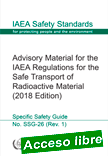 |
Advisory Material for the IAEA Regulations for the Safe Transport of Radioactive Material (2018 Edition)
STI/PUB/1953 ¦ 495 pages ¦ 16 figures ¦ Date published: 2022
This Safety Guide provides recommendations and guidance on achieving and demonstrating compliance with IAEA Safety Standards Series No. SSR-6 (Rev. 1), Regulations for the Safe Transport of Radioactive Material (2018 Edition), which establishes the requirements to be applied to the national and international transport of radioactive material. Transport is deemed to comprise all operations and conditions associated with and involved in the movement of radioactive material, including the design, fabrication and maintenance of packaging, and the preparation, consigning, handling, carriage, storage in transit, shipment after storage and receipt at the final destination of packages.
|
The Advisory Material is not a stand-alone text. It is to be used concurrently as a companion to the IAEA Safety Standards Series No. SSR-6 (Rev. 1) and each paragraph of this guide is numbered correspondingly to the paragraph of the Regulations to which it most directly relates.
|
 |
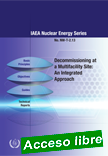 |
Decommissioning at a Multifacility Site: An Integrated Approach
IAEA Nuclear Energy Series No. NW-T-2.13 ¦ STI/PUB/1996 ¦ English ¦ 78 pages ¦ Date published: 2022
In recent years, several Member States have completed the decommissioning of multifacility nuclear sites. This publication consolidates their technical and organizational experience, and provides information and practical guidance that promotes safe, timely and cost effective implementation. All phases of decommissioning are discussed, from planning and dismantling to waste management and site release, as well as organizational schemes and funding.
|
This publication is intended for decision makers, plant operators, contractors and regulators involved in planning, management, authorization and execution of decommissioning activities. It is particularly relevant for multifacility site operators with nuclear facilities approaching the end of their foreseen lifetime. The publication will also be of interest for the designers and builders of new nuclear installations in order to facilitate eventual decommissioning.
|
 |
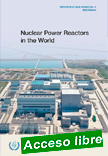 |
Nuclear Power Reactors in the World (2022 Edition)
Reference Data Series No. 2 ¦ English ¦ IAEA-RDS-2/42 ¦100 pages ¦ Date published: 2022
This is the 42nd edition of Reference Data Series No. 2, which presents the most recent reactor data available to the IAEA. It contains summarized information as of the end of 2021 on power reactors operating, under construction and shut down as well as performance data on reactors operating in the IAEA Member States. The information is collected through designated national correspondents in the Member States and the data are used to maintain the IAEA's Power Reactor Information System (PRIS).
|
.
|
 |
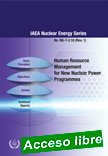 |
Human Resource Management for New Nuclear Power Programmes
IAEA Nuclear Energy Series No. NG-T-3.10 (Rev. 1) ¦ English ¦ STI/PUB/1933 ¦ 48 pages ¦ Date published: 2022
This publication provides Member States with a structured approach to developing an effective human resource management (HRM) strategy, which can be adapted to suit the nature and scope of the national nuclear power programme. It identifies the four components of an integrated HRM strategy particularly relevant for countries developing a nuclear power programme for the first time and examines these issues in the context of each phase of the Milestones Approach.
|
In each phase the publication identifies the required actions related to these issues, and presents observations and lessons learned from Member States.
|
 |
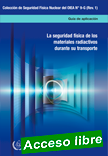 |
La seguridad física de los materiales radiactivos durante su transpor
Colección de Seguridad Física Nuclear 9-G (Rev. 1) ¦ Español ¦ STI/PUB/1872 ¦ 116 págs. ¦ Fecha de publicación: 2022
Esta versión actualizada de la publicación Nº 9 de la Colección de Seguridad Física Nuclear del OIEA, La seguridad física de los materiales radiactivos durante su transporte, va dirigida a facilitar el establecimiento a escala internacional de un enfoque coherente con respecto a la seguridad física de los materiales radiactivos durante su transporte.
|
Toma como base las recomendaciones pertinentes de distintas publicaciones anteriores de la Colección de Seguridad Nuclear del OIEA y es aplicable a la seguridad física de los bultos que contienen materiales radiactivos cuyas consecuencias radiológicas podrían ser inaceptables si se utilizan en un acto doloso durante su transporte internacional o nacional. También es pertinente para la seguridad física de algunos materiales nucleares de categoría III y categorías inferiores durante su transporte a raíz de su carácter radiactivo. Igualmente, figura orientación sobre la protección contra la retirada no autorizada y el sabotaje.
|
 |
 |
Fuel Failure in Normal Operation of Water Reactors: Experience, Causes and Mitigation
IAEA-TECDOC-2004 ¦ 266 pages ¦ 158 figures¦ Date published: 2022
This publication results from an IAEA technical meeting, held with the objective to provide Member States with a forum to share data, experience and knowledge in the area of fuel failure during normal operation of water cooled reactors. In spite of the low fuel failure rate in currently operating water cooled nuclear power reactors, there is a continued high level of interest in fuel failures, owing to the problems and inconvenience caused by fuel failures and to the generally accepted goal of achieving a zero failure rate.
|
This requires a detailed knowledge of existing failure mechanisms, their root causes and remedies. A total of 21 papers addressing those issues were presented and discussed at the meeting. The main conclusions and recommendations are summarized in this publication.
|
 |
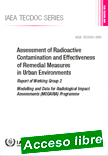 |
Assessment of Radioactive Contamination and Effectiveness of Remedial Measures in Urban Environments
IAEA-TECDOC-2001 ¦ 226 pages ¦ 98 figures ¦ Date published: 2022
Radiological environmental impact assessment models are important tools for public and environmental protection, for example, in planning measures to be taken in the event of accidental releases. This publication was developed to report on results from international model validation exercises conducted within the IAEA's MODARIA I programme to test and improve the modelling for predictions used for environmental transfer and dose assessment in urban areas.
|
Model exercises were focused on: contamination densities and activity concentrations in air following short range atmospheric dispersion and deposition events; prediction of atmospheric dispersion and application of decision support systems under complex meteorological and topographic conditions; and expected reductions in ambient dose rates and activity concentrations due to protective actions following a nuclear accident. The report builds on past IAEA publications and provides relevant examples for use in strengthening the global nuclear safety framework as part of emergency preparedness and response planning following a nuclear or radiological emergency.
|
 |
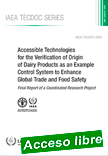 |
Accessible Technologies for the Verification of Origin of Dairy Products as an Example Control System to Enhance Global Trade and Food Safety
IAEA-TECDOC-2002 ¦ 126 pages ¦ 47 figures ¦ Date published: 2022
As well as the application to food irradiation, nuclear techniques can be used in the detection of contaminants and the verification of the origins and authenticity of food. This publication presents the findings of a joint FAO/IAEA coordinated research project (CRP) on utilizing isotope and trace element analysis, and other complementary analytical techniques, to characterize the origin of authentic milk and dairy products sampled by the participating institutes.
|
The purpose of the CRP was to develop a methodology to implement a sustainable system for the independent verification of the claimed origin of food. Questions concerning origin are among the first to be asked when a food safety incident arises. The results of the project described in this publication will assist Member States to better communicate the qualities and origin related attributes, or terroir, of different food commodities. In addition, verifying the origin of food can help to prevent fraud and thereby reduce barriers to trade and protect and promote added-value products with a strong regional or national identity.
|
 |
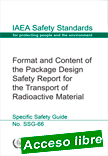 |
Format and Content of the Package Design Safety Report for the Transport of Radioactive Material
IAEA Safety Standards Series No. SSG-66 ¦ STI/PUB/1980 ¦ 108 pages ¦ 2 figures ¦ Date published: 2022
Requirements for the safe transport of radioactive material are established in IAEA Safety Standards Series No. SSR-6 (Rev. 1), Regulations for the Safe Transport of Radioactive Material, 2018 Edition. Packages intended for the transport of radioactive material have to be designed to meet applicable national and international regulations.
|
For package designs that require approval by a competent authority, the documentary evidence of compliance with the applicable regulations is commonly known as package design safety report (PDSR). For package designs that do not require competent authority approval, a PDSR would also be an appropriate form of documentary evidence of compliance with the Transport Regulations. This Safety Guide provides recommendations on the preparation of a PDSR to demonstrate compliance of a package design for the transport of radioactive material with the Transport Regulations. This Safety Guide is intended for use by applicants for approval of package designs (when package designs are subject to competent authority approval) as well as by package designers and/or consignors (when package designs do not require competent authority approval). Regulators will benefit from the common structure for the competent authority assessment process, and designers and consignors will find a consistent approach to justify the compliance of a package design with the regulatory requirements.
|
 |
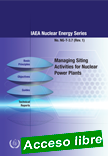 |
Managing Siting Activities for Nuclear Power Plants
IAEA Nuclear Energy Series No. NG-T-3.7 (Rev.1) ¦ STI/PUB/2000 ¦English ¦ 78 pages ¦Date published: 2022
Member States continue to request guidance on introducing nuclear power to their power production strategy. This revised publication presents developments in managing siting activities since the 2012 edition. It provides the updated methodology and framework to assist Member States in site identification, selection, evaluation and licensing, and discusses aspects including nuclear safety and security, technology and engineering, economics and cost, land use planning and preparation, socioeconomic impacts and involvement of stakeholders.
|
The intended users include decision makers, senior managers and other technical specialists involved in siting and site evaluation. It is also relevant for Member States seeking to expand existing nuclear power programmes.
|
 |
| |
|
|

|
|
|
| |
|
|
| |
| |
|
|
| |
| |
|
|
| |
| |
|
|
|
| |
| |
